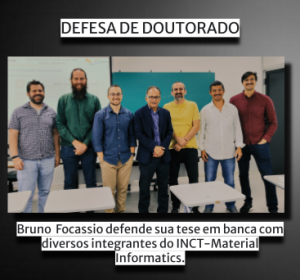2023
Claro, Pedro I. C.; Borges, Egon P. B. S.; Schleder, Gabriel R.; Archilha, Nathaly L.; Pinto, Allan; Carvalho, Murilo; Driemeier, Carlos E.; Fazzio, Adalberto; Gouveia, Rubia F.
From micro- to nano- and time-resolved x-ray computed tomography: Bio-based applications, synchrotron capabilities, and data-driven processing Journal Article
Em: vol. 10, não 2, 2023, ISSN: 1931-9401.
@article{Claro2023,
title = {From micro- to nano- and time-resolved x-ray computed tomography: Bio-based applications, synchrotron capabilities, and data-driven processing},
author = {Pedro I. C. Claro and Egon P. B. S. Borges and Gabriel R. Schleder and Nathaly L. Archilha and Allan Pinto and Murilo Carvalho and Carlos E. Driemeier and Adalberto Fazzio and Rubia F. Gouveia},
doi = {10.1063/5.0129324},
issn = {1931-9401},
year = {2023},
date = {2023-06-01},
volume = {10},
number = {2},
publisher = {AIP Publishing},
abstract = {X-ray computed microtomography (μCT) is an innovative and nondestructive versatile technique that has been used extensively to investigate bio-based systems in multiple application areas. Emerging progress in this field has brought countless studies using μCT characterization, revealing three-dimensional (3D) material structures and quantifying features such as defects, pores, secondary phases, filler dispersions, and internal interfaces. Recently, x-ray computed tomography (CT) beamlines coupled to synchrotron light sources have also enabled computed nanotomography (nCT) and four-dimensional (4D) characterization, allowing in situ, in vivo, and in operando characterization from the micro- to nanostructure. This increase in temporal and spatial resolutions produces a deluge of data to be processed, including real-time processing, to provide feedback during experiments. To overcome this issue, deep learning techniques have risen as a powerful tool that permits the automation of large amounts of data processing, availing the maximum beamline capabilities. In this context, this review outlines applications, synchrotron capabilities, and data-driven processing, focusing on the urgency of combining computational tools with experimental data. We bring a recent overview on this topic to researchers and professionals working not only in this and related areas but also to readers starting their contact with x-ray CT techniques and deep learning.},
keywords = {General Physics and Astronomy},
pubstate = {published},
tppubtype = {article}
}
X-ray computed microtomography (μCT) is an innovative and nondestructive versatile technique that has been used extensively to investigate bio-based systems in multiple application areas. Emerging progress in this field has brought countless studies using μCT characterization, revealing three-dimensional (3D) material structures and quantifying features such as defects, pores, secondary phases, filler dispersions, and internal interfaces. Recently, x-ray computed tomography (CT) beamlines coupled to synchrotron light sources have also enabled computed nanotomography (nCT) and four-dimensional (4D) characterization, allowing in situ, in vivo, and in operando characterization from the micro- to nanostructure. This increase in temporal and spatial resolutions produces a deluge of data to be processed, including real-time processing, to provide feedback during experiments. To overcome this issue, deep learning techniques have risen as a powerful tool that permits the automation of large amounts of data processing, availing the maximum beamline capabilities. In this context, this review outlines applications, synchrotron capabilities, and data-driven processing, focusing on the urgency of combining computational tools with experimental data. We bring a recent overview on this topic to researchers and professionals working not only in this and related areas but also to readers starting their contact with x-ray CT techniques and deep learning.
Silvestre, G. H.; de Lima, F. Crasto; Bernardes, J. S.; Fazzio, Adalberto; Miwa, Roberto H.
Nanoscale structural and electronic properties of cellulose/graphene interfaces Journal Article
Em: Phys. Chem. Chem. Phys., vol. 25, não 2, pp. 1161–1168, 2023, ISSN: 1463-9084.
@article{Silvestre2023,
title = {Nanoscale structural and electronic properties of cellulose/graphene interfaces},
author = {G. H. Silvestre and F. Crasto de Lima and J. S. Bernardes and Adalberto Fazzio and Roberto H. Miwa},
doi = {10.1039/d2cp04146d},
issn = {1463-9084},
year = {2023},
date = {2023-01-04},
urldate = {2023-01-04},
journal = {Phys. Chem. Chem. Phys.},
volume = {25},
number = {2},
pages = {1161--1168},
publisher = {Royal Society of Chemistry (RSC)},
abstract = {The development of electronic devices based on the functionalization of (nano)cellulose platforms relies upon an atomistic understanding of the structural and electronic properties of a combined system, cellulose/functional element.},
keywords = {General Physics and Astronomy, Physical and Theoretical Chemistry},
pubstate = {published},
tppubtype = {article}
}
<jats:p>The development of electronic devices based on the functionalization of (nano)cellulose platforms relies upon an atomistic understanding of the structural and electronic properties of a combined system, cellulose/functional element.</jats:p>





